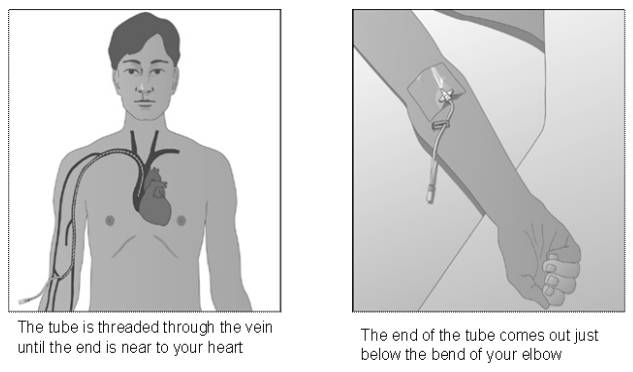Peripherally Inserted Central Catheters (PICCs)
Please note, this page is printable by selecting the normal print options on your computer.
Introduction
Your consultant has decided that the best way for you to receive your treatment is through a peripherally inserted central catheter (PICC), often referred to as a PICC line.
What is a PICC?
A PICC is a long, flexible tube that is inserted into a large blood vessel in the upper arm. It can be used for giving treatments such as chemotherapy, antibiotics, fluids and pain management drugs. It can also be used to take blood samples or to give blood transfusions. The PICC is made of a thin, soft, nonirritant material so it can be left in place for many weeks or months, depending on how long you need it. It is threaded up the arm until the tip sits in a large vein just above the heart. This makes it possible for you to have your treatment without the need for further needles to be
inserted into your veins.
How are they put in?
The PICC will be put in whilst you are in hospital or as an outpatient by a doctor or a Nurse Specialist using sterile technique. Some local anaesthetic will be used to prevent any pain during the
procedure. Once in place, it will be fixed with a special securement (Statlock/ Griplock) and a clear dressing. An x-ray will then be carried out to check your PICC is in the right place.

Possible risks and complications
Every procedure carries some risks and complications. One of the main risks is infection so it is important that you keep the site as clean as you can. Before the PICC is inserted the risks will fully explained to you to ensure you are happy to proceed. You will also be asked for your consent before going ahead. If after you have had the line inserted, and you notice any of the following, you should inform your nurse or doctor as soon as possible:
• Increased redness around the point of entry
• Bleeding or discharge at the point of entry
• Swelling, redness or pain anywhere in your arm, chest or neck
• You feel feverish or have a temperature
Looking after your PICC
Once in place, it is important that you understand how to take care of your PICC to prevent it coming out and / or getting infected.
• Clean your hands: If you ever need to handle your PICC, always wash your hands with soap and water and dry your hands first.
• Keep the dressing clean and dry: A nurse will clean the area where the PICC goes into your skin and change your dressing and bung at the end of the PICC once a week.
• However, if at any time your dressing becomes loose or detached from your skin, you should try to secure the PICC with tape or a bandage and contact your nurse to arrange for a new dressing to be applied as soon as possible.
• Check your line daily. This will help to make sure the PICC has not come out. If you can see more tube coming out of the insertion site than before, this might be a sign that the PICC has moved. Let your nurse know before the PICC is used again. You may need to have another X-ray to check the position.
Baths and showers You can have a bath and shower. The dressing is splash proof but you should wrap with clingfilm around your arm to add extra protection. Do not soak your arm underwater, and always dab the dressing dry if it becomes wet. You should never go swimming with a PICC in place.
How is the PICC removed?
When the doctor decides that you no longer need a PICC, it will be removed. This is usually done by a nurse in an outpatient department or in your home. It is gently pulled out – this is painless and takes only a few minutes. A dressing will be applied to the break in your skin, which should be left on for 24 hours and can then be removed.
Who to contact
If at any time you are worried about your PICC, you should not hesitate to contact the Community or OPAT Nurse where you are receiving your treatment. They will be more than happy to discuss your concerns and, if necessary, check your line.
Telephone: 01908 660033 Bleep 1234 or 01908 996573 (Mon- Sun) or your Community Nurse Team: 9am – 5pm. Out-of-Hours: 01908 996568.
